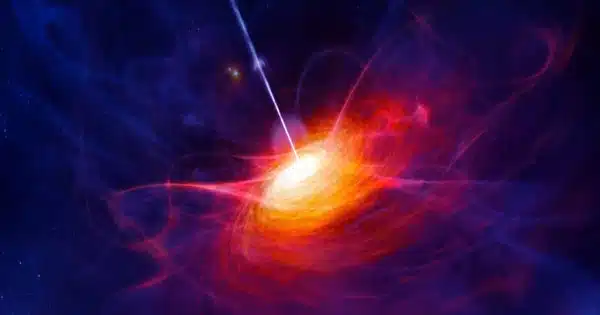According to astronomers, the brightest burst of light ever witnessed in the night sky last year affected Earth’s upper atmosphere in a way never before detected.
On October 9, 2022, a tremendous burst of gamma rays from a massive cosmic explosion two billion light years away arrived at Earth, lighting up telescopes all across the planet.
The flare, quickly dubbed the “BOAT”—for Brightest Of All Time—lasted about seven minutes, but its afterglow was visible to amateur astronomers for seven hours.
The flash ignited lightning detectors in India and alerted machines that ordinarily analyze solar flares, which are explosions in the sun.
It also had an impact on long-wave radio communications in the lower ionosphere, a region of the Earth’s upper atmosphere located between 60 and 350 kilometers (37 to 217 miles) above the surface.

The BOAT also impacted the high ionosphere, marking the first time a gamma-ray burst was seen in this region of the atmosphere, according to a team of Italian and Chinese experts on Tuesday.
The upper ionosphere is located 350 to 950 kilometers above Earth, at the border of space, and is where solar energy converts into charged particles that form an important electric field.
Mirko Piersanti, a researcher at Italy’s University of L’Aquila, told AFP that scientists have been discussing whether gamma ray bursts had any effect on the upper ionosphere for two decades.
“I think we finally answered the question,” Piersanti, the primary author of a new study published in the journal Nature Communications, stated.
According to him, the researchers were fortunate that the Chinese-Italian CSES satellite, which contains an electric field detector, “was exactly in the zone that was illuminated by the gamma-ray burst” 500 kilometers above Earth in the upper ionosphere.
“We found a shape in the electric field that had never been observed before,” Piersanti said.
“It is amazing,” said European Space Agency gamma-ray expert Erik Kuulkers in a statement.
“We can see things that are happening in deep space but are also affecting Earth.”
Extinction threat?
According to Piersanti, the study will assist scientists in comprehending the possible threat that further gamma-ray bursts may pose in the future.
The worst-case scenario would be for such a massive blast to originate far closer to home, say, within our own Milky Way galaxy. According to him, this may “completely erase” the Earth’s ozone layer.
Everything on the surface would be exposed to the full force of the sun’s UV radiation, perhaps wiping out life on Earth.
There has previously been a suggestion that ancient mass extinction events were caused by gamma-ray bursts.
However, Piersanti stressed that much remains unclear.
He further emphasized that the ionosphere might absorb all of the gamma rays and “nothing would happen” to those of us on the ground.
The GRB 221009A gamma-ray burst last year is thought to have been triggered by either a large dying star exploding into a supernova or the formation of a black hole.
Given its enormous power, it might have been both—a supernova explosion followed by the formation of a black hole.
The blast originated in the constellation Sagitta and traveled an estimated 1.9 billion years to Earth.
Because of the expansion of the cosmos, it is currently 2.4 billion light-years away.
Every day, more than one gamma-ray burst hits Earth.
One with the brightness of the BOAT, on the other hand, is anticipated to occur once every 10,000 years.















